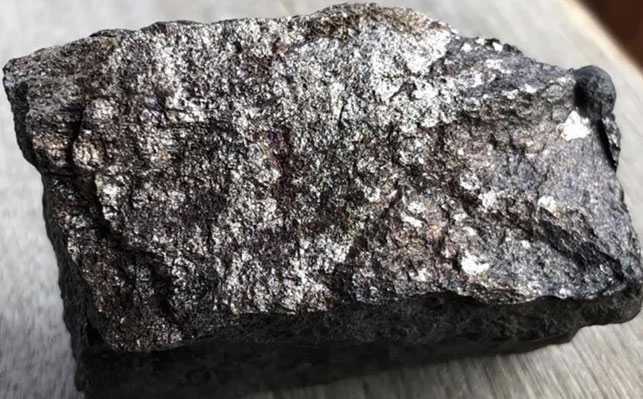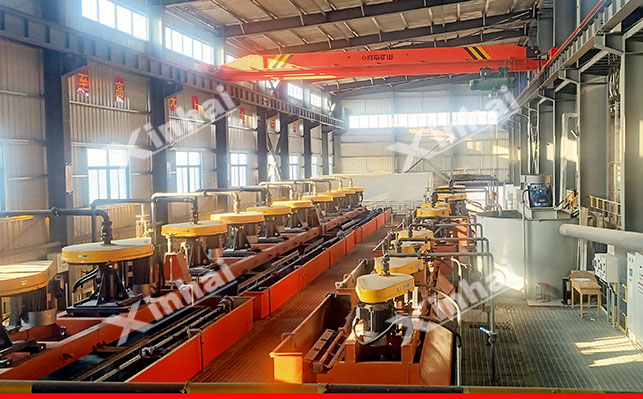
15311826613
Click to add WeChatSilver-lead concentrate is an intermediate product obtained through beneficiation processes from lead ores containing silver or lead-silver co-occurring ores. It is an important raw material for the smelting of silver and lead. Among this type of minerals, silver mostly exists in the form of natural silver and silver sulfide, while lead is mostly found in galena. In ores with a higher degree of oxidation, it may also exist in the form of cerussite and anglesite. This article will introduce how to separate silver-lead concentrate.
Silver-lead concentrate is mainly obtained from silver-lead ores. Such ores can be classified into the following types according to their mineral composition and genesis:

Silver sulfide lead ore: This is a common type of ore, in which lead mainly exists in the form of galena, and silver mainly exists in the form of sulfides such as Ag₂S and spirulite, and is often closely associated with galena. In addition, the ore may also contain other sulfide minerals such as sphalerite, pyrite and chalcopyrite, as well as gangue minerals such as quartz and calcite.
Silver-lead oxide ores: They are mostly formed by the weathering of silver-lead sulfide ores. Lead mainly exists in the form of cerussite and anglesite, while silver exists in the form of oxidized minerals such as cerussite. This type of ore is relatively rare and difficult to separate.
Silver and lead are closely associated in silver-lead concentrates, making their separation rather difficult. Currently, the commonly used separation methods mainly include flotation, pyrometallurgical separation and hydrometallurgical separation.
The flotation method for separating silver-lead concentrates can mainly be classified into two processes based on the different objects to be suppressed: lead-suppressed silver flotation and silver-suppressed lead flotation.
Lead suppression and silver floating: Use inhibitors such as potassium dichromate and potassium nitrate to suppress galena, causing silver minerals to float up. Potassium dichromate inhibitors can react with the surface of galena to form insoluble lead chromate films, causing it to lose its floatability, but their inhibitory effect on silver minerals is relatively weak. During the flotation process, the pH value of the pulp is adjusted to 8-9, which is weakly alkaline. An appropriate amount of inhibitors are added, and then xanthate collectors and foaming agents are added to float silver minerals. Silver concentrate and lead tailings can be obtained.
Silver suppression and lead flotation: When silver mainly exists in galena in the form of isomorphism, cyanide can be used to suppress silver minerals and float galena. Cyanide can react with silver ions to form stable complexes, making the surface of silver minerals hydrophilic and thus inhibited, while having a relatively small impact on the collection of galena. During flotation, the pH value of the pulp is adjusted to 10-11, an appropriate amount of sodium cyanide is added to suppress silver minerals, and then xanthate is used to collect galena to obtain lead concentrate and silver tailings.

The pyrometallurgical separation of silver-lead concentrate is based on the differences in melting and boiling points of galactic lead, and the separation is achieved through high-temperature smelting. After being mixed with flux, the silver-lead concentrate is sent into a reflectivity furnace or a blast furnace for smelting. Under high-temperature conditions above 1000℃, galena decomposes into metallic lead and sulfur dioxide. Metallic lead forms lead melt, while silver, due to its higher density and miscibility with lead, enters the lead melt to form a lead-silver alloy. Subsequently, the lead-silver alloy undergoes electrolytic refining. During the electrolysis process, lead precipitates at the cathode while silver enters the anode slime, thus achieving the separation of silver and lead.
Pyrometallurgical separation is mostly suitable for processing silver-lead concentrates with relatively high grades, but it has high energy consumption and can produce harmful gases such as sulfur dioxide, thus requiring environmental protection facilities.
Wet separation of silver-lead concentrate is carried out by taking advantage of the differences in solubility characteristics of silver and lead in various solvents. Commonly used methods include acid leaching and ammonia leaching.
Acid leaching method: Lead is leached out by acid solutions such as nitric acid and sulfuric acid, leaving silver in the residue. Galena reacts with acid solution to form soluble lead nitrate (sulfide) that enters the solution, while silver minerals are insoluble in dilute nitrate (sulfide) acid. After filtration, silver residue and lead-containing solution can be obtained, and then lead is recovered from the lead-containing solution.
Ammonia leaching method: In an ammonia solution, lead can form soluble complex ions with ammonia and be leached out, while silver is insoluble in an ammonia solution. Silver-lead concentrate is mixed with ammonia water and oxidant, and leaching is carried out at room temperature. Galena is oxidized and reacts with ammonia to enter the solution, while silver remains in the leaching residue, achieving the separation of silver and lead.
The above is an introduction to the separation methods of silver-lead concentrate. In actual beneficiation plants, the separation methods of silver-lead concentrate need to be comprehensively selected based on factors such as the mineral composition of the concentrate, the content of silver and lead, and their occurrence states.
Xinhai can provide mining services for silver and lead mines, including mining and beneficiation as well as tailings treatment, etc. We can provide a complete set of solutions for it, including mineral processing tests, process flow design, complete sets of equipment, installation and commissioning of the beneficiation plant, as well as later operation and management services. If you have any needs, please feel free to consult.